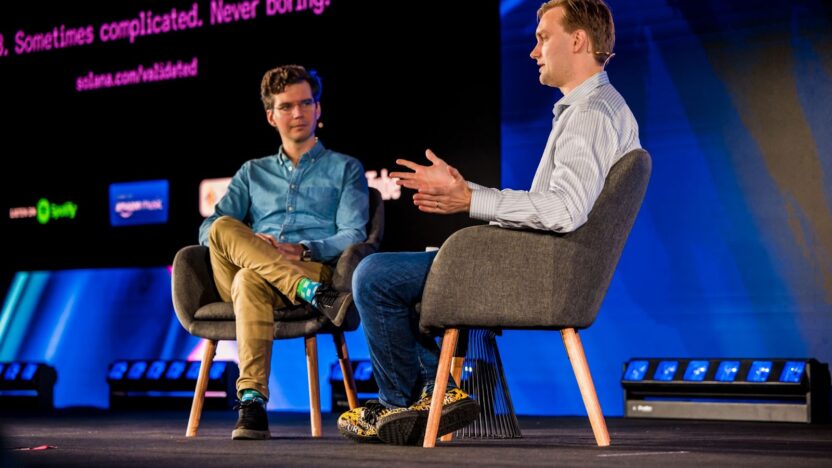With a market cap of over US$1.2 trillion, Bitcoin is the first and by far the largest cryptocurrency. It began as peer-to-peer electronic cash and later evolved into what its proponents say is akin to portable gold as a store of value, but where does it go from there? That’s what Stefan Rust, founder and CEO of Hydro Labs, an incubator for decentralized finance technologies, and Brittany Laughlin, executive director of Stacks Foundation, an open-source network for building smart-contract and decentralized finance bridges to the Bitcoin blockchain, discussed in Innovating on Bitcoin Network, a fireside chat at today’s Bitcoin & Beyond Virtual Summit hosted by AAX and Forkast.News.
While Bitcoin has huge locked value, these unrealized gains “[aren’t] doing anything,” Laughlin said. “What we’ve seen from DeFi and other categories is that people want to be able to leverage this asset they have in the same way they do in the real world where you can leverage against your house or you can leverage capital stocks that you own,” she added.
The problem with increasing functionality is the corresponding increase in the number of transactions that can clog the Bitcoin blockchain. That’s why enablers like Stacks are emerging to help address the challenge — provide more functionality without increasing transactions on the main Bitcoin blockchain.
Services similar to that of Stacks also exist in the market although their objects and functionalities may differ. For instance, Liquid Network, a sidechain protocol built on top of the Bitcoin blockchain, acts as a settlement network for traders and exchanges, enabling faster, more confidential Bitcoin transactions.
Although people are skeptical about anything that is built on the Bitcoin blockchain with its own token, “fundamentally people do want more functionality in Bitcoin than they have today,” Laughlin said.
That’s because “people that are owning BTC or investors that own BTC are looking to participate in some of the innovation that’s taking place in the DeFi world, in the NFT world, in the DAO world, on Ethereum or some of the other chains,” Rust said.
Stacks enables people to use their Bitcoin in ways that did not exist until a few years ago, Laughlin said. “The power of Bitcoin and ownership go hand in hand and at Stacks, we just want people to be able to own other things as well, like digital art or other financial assets that they have or their identity. And all of that should be tied to the Bitcoin blockchain.”
Stacks launched its mainnet in January that enabled smart contracts tied to the Bitcoin blockchain through proof-of-transfer mechanism. Instead of mining Bitcoin with electricity for proof-of-work, in proof-of-transfer miners contribute Bitcoin to win a block. When miners contribute Bitcoin, some of that Bitcoin is automatically sent to a burn address while the remaining Bitcoins are redistributed among Stacks holders participating in consensus.
To participate in a consensus, users need to lock in their Bitcoin for a two-week cycle — a process known as stacking. Users do not, however, need to give up custody of their Bitcoin. The coins remain in their wallet but get locked in a smart contract.
“So miners are submitting Bitcoin and earning Stacks [token], and then the stackers are earning about a 10% yield of Bitcoin. So, just by holding stacks, you’re earning Bitcoin, which is pretty novel,” Laughlin said. Usually, staking programs allow users to earn only in the token that they hold, unlike Stacks which rewards Bitcoin to Stacks holders. Moreover, Stacks also allows users to team up with others if they do not hold enough tokens to stake on their own, Laughlin explained.
Further, Stacks also enables MiamiCoin, the cryptocurrency launched by the city of Miami. “What I love is in essence, the choice that is being given to consumers with Miami coin. All of a sudden, a municipality or a city can decide we’re going to create a mint or own token and there’s a toolset there” on Stacks to enable that, Rust said.
MiamiCoin was designed to benefit the city — 30% of proceeds from MiamiCoin sales go directly to the city for investment or use while the rest goes to users. The city claims that the virtual currency raked in over US$7 million dollars for the city’s treasury in August. Miami Mayor Francis Suarez believes the crypto token could generate as much as $60 million for his city over the next year, according to a Washington Post report.
Other cities are following Miami into the crypto realm. Starting Wednesday, New York City will begin mining its own token NYCCoin, which the city’s mayor-elect Eric Adams welcomed in several tweets and interviews. The NYCCoin is the second city token developed by CityCoins, after Miami’s, and is also based on Stacks.
Smart contracts also enable Bitcoin use cases for financial services like lending. In places like South America, where lending is expensive and difficult to procure, facilitating lending “[opens] the world up to a lot of tools,” Laughlin said.





